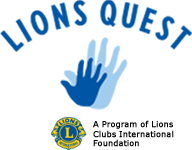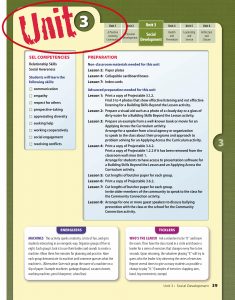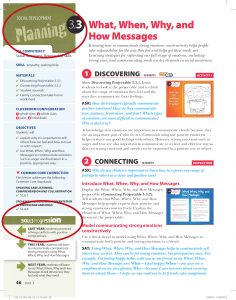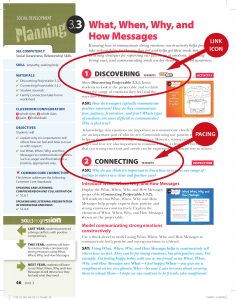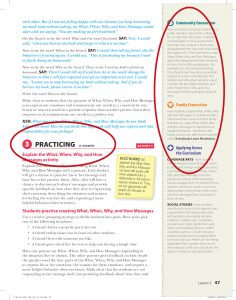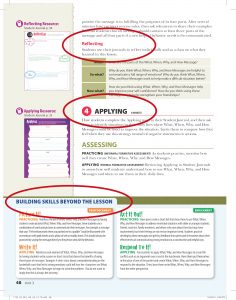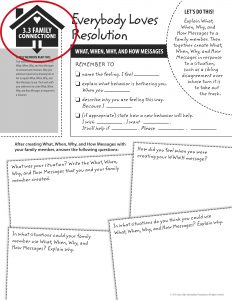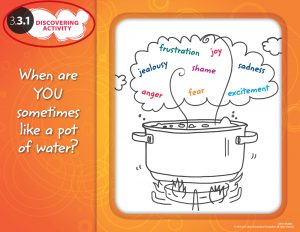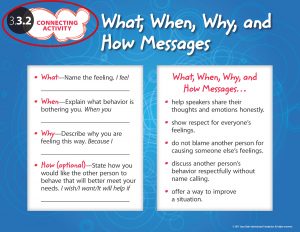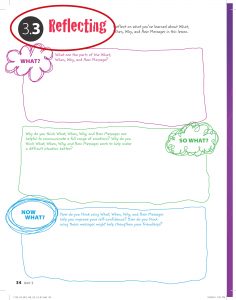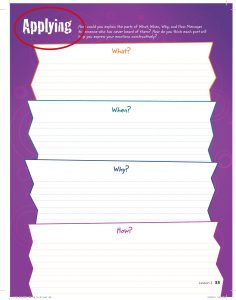Easy to Implement Lessons
Each three-page lesson in the Facilitator Guide provides instruction that addresses specific SEL competencies, skills, and lesson objectives. Each lesson also provides direction for facilitators regarding how and when to use projectables, the Student Journal, and Family Connection take-home worksheets.
Click on the thumbnail images below to view a larger version of any sample page.
You can also download a PDF version of this guide for reference.
Facilitator’s Resource Guide
Unit Opener
The first page of each unit provides organizational tools, materials needed for the unit, Tickler activities for student engagement, and Energizer activities for skills reinforcement.
Planning
Each lesson begins with a PLANNING COLUMN, which shows the unit and lesson number; lists the lesson’s SEL competencies, skills, and objectives; explains the classroom configurations for each of the lesson’s four phases; and lists Common Core standards covered in the lesson.
Skills Progression
This section, in the left column, provides the instructional context for a particular skill – what students learned last year, what they are learning this year, and what they will learn next year.
Discovering
Each lesson begins with a DISCOVERING PHASE — an engaging introductory activity that involves all students. The DISCOVERING PROJECTABLE facsimiles show opposite the instruction.
Note: The Lesson Link icon reminds facilitators to review any work completed by students for a previous lesson.
Connecting
The CONNECTING PHASE, students connect what they already know with new information about the lesson skill. If the lesson includes a CONNECTING PROJECTABLE, a facsimile is show opposite the instruction.
Note: The Pacing value indicates the time suggested for each phase. Pacing will vary depending on class length and on student needs.
Practicing
In the PRACTICING PHASE, students practice the new skill learned in the Connecting phase. If the lesson includes a Practicing projectable, a facsimile is shown opposite the instruction.
Community, Family & Application
The COMMUNITY CONNECTION, FAMILY CONNECTION, and APPLYING ACROSS THE CURRICULUM column provides opportunities for students to expand the lesson’s skills and concepts beyond the classroom.
Reflecting
The REFLECTING QUESTIONS conclude the Practicing phase. The questions reflect increasing cognitive complexity and connect students to the learning that took place in the just-completed Connecting and Practicing phases. Questions are open-ended and encourage divergent and critical thinking. Questions that express a personal opinion, perspective, or insight invite students to reveal how they are thinking about a topic.
Applying
In the APPLYING PHASE students use higher-order thinking skills to apply what they have learned beyond the classroom. Students either complete or prepare for this activity using the Student Journal.
Beyond the Lesson
Finally, in the BUILDING SKILLS BEYOND THE LESSON section, additional activities are provided for students who may benefit from additional exposure to the lesson skills and for students who have mastered the skills and are ready for activities with a greater degree of complexity.
Digital Resources
Family Connection
THE FAMILY-CONNECTION TAKE-HOME WORKSHEET is a black line master that teachers can copy and distribute to students to practice the lesson’s skill at home with a family member. Worksheets are provided as PDFs on the Lions Quest Digital Resources Drive.
Projectables
The PROJECTABLES are provided as PDFs on the LQ Digital Resources Drive. They can be projected on a whiteboard or printed and distributed to students, depending on the needs of the lesson. Lessons use one or more projectables to stimulate discussion and support instruction.
Projectables are numbered with the unit and lesson number, followed by a number indicating the corresponding phase of instruction in the lesson. The number 1 indicates Discovering phase, 2 indicates Connecting phase, and 3 indicates Practicing phase. Some projectables are used in more than one lesson, so the projectable number refers to the first unit and lesson in which the projectable is used.
Each student has their own Student Journal. Some lessons have Student Journal pages that correspond to one or more of the other instructional phases.
Reflecting Journal
The REFLECTING PAGE includes the same Reflecting questions from the Facilitator’s Resource Guide. Students have space in their Student Journal to write their answers.
